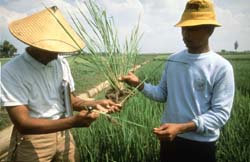
 Development Assistance
Development Assistance
 Development Assistance
Development Assistance

|
In addition to the dangers to human health and the environment posed by these highly toxic chemicals, scientists discovered that insecticides killed beneficial insects along with pests. In Indonesia, for example, the density of the brown planthopper insect, which feeds only on rice, grew by 100 to 1 000 times after the application of insecticides. The insecticide was more efficient at killing the natural enemies of the planthopper, which were helping contain the pest, than against the culprit itself.
Experts tackled this problem by developing Integrated Pest Management (IPM), which uses biological control methods and natural predators such as spiders and wasps to stave off pests, grow a healthy crop and reduce reliance on costly pesticides.
FAO now has a major programme to promote IPM, which has helped train 200 000 farmers in Indonesia to grow rice without their formerly heavy use of pesticides. The results have been dramatic. Rice yields have increased. Pesticide use has plummeted. And the Indonesian government has saved more than $120 million a year in pesticide subsidies.
IPM techniques are now being adapted and extended to other crops
and regions. A project in the Sudan trained 300 agricultural
experts and 2 500 rural workers to apply IPM principles to cotton
and rotational food crops. FAO has also organized study tours so
plant protection specialists from Africa, the Near East and Latin
America can study IPM firsthand in the fields of Asia.
Comments?: [email protected]